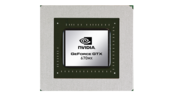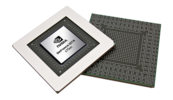NVIDIA GeForce GTX 670MX vs NVIDIA GeForce GTX 680MX vs NVIDIA GeForce GTX 675MX
NVIDIA GeForce GTX 670MX ► remove from comparison Die NVIDIA GeForce GTX 670MX ist eine High-End Grafikkarte für Notebooks. Trotz des ähnlichen Namens zur Fermi-basierten GTX 670M basiert die GTX 670MX auf dem neueren Kepler GK106 Kern in 28nm. Im Vergleich zur GTX 675MX bietet die 670MX einen verringerten Speicherbus und langsamer getaktete Speicherchips. Dadurch ist die Speicherbandbreite von 115,2 GB/s auf 67,2 GB/s reduziert.
Architektur
Mit Kepler löst Nvidia die bisherige Fermi-Architektur ab, die unter anderem bei verschiedenen Chips und Modellen der GeForce-500M-Serie zum Einsatz kam. Der GK106 verfügt als Kepler-Chip über 5 Shader-Blöcke mit je 192 CUDA Cores, die vom Hersteller mit dem Kürzel SMX bezeichnet werden. Bei der 670MX sind davon alle 5 aktiviert. Zwei SMX bilden zusammen mit zwei Polymorph Engines und einer gemeinsamen Raster Engine einen sogenannten GPC (Graphics Processing Cluster). Da die Shader keine eigene Takt-Domain mehr besitzen (Hot Clock), entspricht die Rechenleistung in etwa der Hälfte der Einheiten der Fermi-Architektur mit doppelter Taktrate. Diese Änderung ist einer der Gründe dafür, dass sich laut Nvidia die Energieeffizienz gegenüber dem Vorgänger verdoppelt hat. Auch die Tesselations-Leistung soll - speziell bei hohen Faktoren - noch einmal deutlich verbessert worden sein.
Als weitere Neuerungen werden zudem erstmals PCIe 3.0 sowie ein noch nicht näher bezeichneter, optionaler Turbo-Modus unterstützt. Dieser kann - ausreichende Kühlungsreserven vorausgesetzt - die Kerntaktrate um bis zu 15 Prozent anheben. Da der Turbo vom BIOS gesteuert wird, steht er, falls vom Notebook-Hersteller implementiert, unabhängig vom Betriebssystem zur Verfügung.
Leistung
Die Leistung der GeForce GTX 670MX liegt etwas oberhalb der alten GTX 670M und dadurch in der Oberklasse der Notebookgrafikkarten in 2012. Die meisten anspruchsvollen Spiele wie Anno 2070 oder Battlefield 3 sind somit in hohen Auflösungen und Detailstufen flüssig darstellbar, teils auch mit zusätzlichem Antialiasing (Stand 2012).
Features
Das aktualisierte Featureset umfasst nun die Unterstützung von bis zu 4 aktiven Displays (mit Optimus u.U. weniger), die mit einer maximalen Auflösung von 3.840 x 2.160 Pixeln zum Beispiel über DisplayPort 1.2 oder HDMI 1.4a angesteuert werden können. HD-Audio-Formate wie Dolby True HD und DTS-HD lassen sich als Bitstream an einen geeigneten Receiver senden. Wie in der Vergangenheit kann jedoch auch weiterhin 3D Vision nicht mit Optimus-Unterstützung kombiniert werden.
Der HD-Videoprozessor der fünften Generation (VP5) wurde vom GF119-Chip übernommen. Dieser kann die Formate MPEG-1, MPEG-2, MPEG-4, H.264 und VC1/WMV9 bis zu einer Auflösung von 4k decodieren und somit den Prozessor entlasten. Auch zwei parallele Streams, beispielsweise für Picture-in-Picture bei einer Blu-Ray, sind möglich. Eine weitere Neuerung ist die Integration eines dedizierten Videoencoders ähnlich Intels Quick Sync, der über die NVENC-API angesprochen werden kann.
Die Leistungsaufnahme der GTX 670MX sollte auf dem selben Level oder etwas unterhalb der GTX 670M liegen, somit eignet sich die Grafikkarte für große und schwere Notebooks (15-17"+). Bei geringer Last helfen zusätzliche Taktstufen, um Energie zu sparen. Im Leerlauf kann die GPU mithilfe der Optimus-Technologie zugunsten einer integrierten Grafikeinheit auch vollständig deaktiviert werden (nur ohne 3D Vision).
NVIDIA GeForce GTX 680MX ► remove from comparison Die NVIDIA GeForce GTX 680MX ist eine mobile, DirectX 11 fähige Grafikkarte der High-End-Klasse, welche speziell für den Einsatz in Apples iMac vorgesehen ist. Sie basiert wie die GTX 680M auf dem GK104-Chip der Kepler-Architektur (28-nm-Prozess), bietet allerdings statt 1344 alle 1536 1D-Shader. Die Kerntaktrate ist mit 720 MHz jedoch identisch. Der Speichertakt (GDDR5) wurde von 900 auf 1.250 MHz (5.000 MHz effektiv) angehoben, wodurch die Speicherbandbreite von 115.2 auf 160 GB/s steigt.
Architektur
Mit Kepler löst Nvidia die bisherige Fermi-Architektur ab, die unter anderem bei verschiedenen Chips und Modellen der GeForce-500M-Serie zum Einsatz kam. Der GK104 verfügt als Kepler-Chip über 8 Shader-Blöcke mit je 192 CUDA Cores, die vom Hersteller mit dem Kürzel SMX bezeichnet werden. Bei der 680MX sind alle 8 aktiviert. Zwei SMX bilden zusammen mit zwei Polymorph Engines und einer gemeinsamen Raster Engine einen sogenannten GPC (Graphics Processing Cluster). Da die Shader keine eigene Takt-Domain mehr besitzen (Hot Clock), entspricht die Rechenleistung in etwa der Hälfte der Einheiten der Fermi-Architektur mit doppelter Taktrate. Diese Änderung ist einer der Gründe dafür, dass sich laut Nvidia die Energieeffizienz gegenüber dem Vorgänger verdoppelt hat. Auch die Tesselations-Leistung soll - speziell bei hohen Faktoren - noch einmal deutlich verbessert worden sein.
Als weitere Neuerungen werden zudem erstmals PCIe 3.0 sowie ein noch nicht näher bezeichneter, optionaler Turbo-Modus unterstützt. Dieser kann - ausreichende Kühlungsreserven vorausgesetzt - die Kerntaktrate um bis zu 15 Prozent anheben. Da der Turbo vom BIOS gesteuert wird, steht er, falls vom Notebook-Hersteller implementiert, unabhängig vom Betriebssystem zur Verfügung.
Leistung
Die Grafikleistung sollte durch die zusätzlichen Shadereinheiten sowie den deutlich gesteigerten Speichertakt um etwa 15 bis 25 Prozent oberhalb der GTX 680M liegen. Die GTX 680MX ist damit die schnellste mobile Grafikkarte (wenn auch nur in Apples iMac eingesetzt) und sollte das Niveau einer Desktop GTX 580 erreichen. Nahezu alle Spiele des Jahres 2012 sind damit in maximalen Einstellungen und hoher Auflösung flüssig spielbar.
Battlefield 3 zum Beispiel war in der nativen Auflösung mit 30 fps (Ultra Settings ) in unserer Benchmarksequenz noch flüssig spielbar. Für Multiplayergefechte empfiehlt sich jedoch auf Antialiasing zu verzichten, oder auf 1920x1080 (45 fps) zurückzuschalten.
Features
Das aktualisierte Featureset umfasst nun die Unterstützung von bis zu 4 aktiven Displays (mit Optimus u.U. weniger), die mit einer maximalen Auflösung von 3840 x 2160 Pixeln zum Beispiel über DisplayPort 1.2 oder HDMI 1.4a angesteuert werden können. HD-Audio-Formate wie Dolby True HD und DTS-HD lassen sich als Bitstream an einen geeigneten Receiver senden. Wie in der Vergangenheit kann jedoch auch weiterhin 3D Vision nicht mit Optimus-Unterstützung kombiniert werden.
Der HD-Videoprozessor der fünften Generation (VP5) wurde vom GF119-Chip übernommen. Dieser kann die Formate MPEG-1, MPEG-2, MPEG-4, H.264 und VC1/WMV9 bis zu einer Auflösung von 4k decodieren und somit den Prozessor entlasten. Auch zwei parallele Streams, beispielsweise für Picture-in-Picture bei einer Blu-Ray, sind möglich. Eine weitere Neuerung ist die Integration eines dedizierten Videoencoders ähnlich Intels Quick Sync, der über die NVENC-API angesprochen werden kann.
Gegenüber der GTX 680M (100 Watt) dürfte die Leistungsaufnahme weiter angestiegen sein, was die Kühlung der Grafikkarte erschwert. Bislang ist uns kein Hersteller bekannt, der die GTX 680MX auch in Notebooks verbauen möchte, sodass sich der Einsatz auf Apples iMac beschränkt. Gerüchte sprechen derzeit von 122 Watt Stromverbrauch. Im Leerlauf kann die GPU mithilfe der Optimus-Technologie zugunsten einer integrierten Grafikeinheit auch vollständig deaktiviert werden (nur ohne 3D Vision).
NVIDIA GeForce GTX 675MX ► remove from comparison Die NVIDIA GeForce GTX 675MX ist eine DirectX 11.1 fähige Notebook-Grafikkarte der Oberklasse. Sie ist die Nachfolgerkarte der noch Fermi basierten GTX 675M und basiert auf dem GK104-Chip der Kepler-Architektur (28-nm-Prozess). Dadurch ist sie der GTX 680M ähnlich, bietet jedoch weniger Shader.
Architektur
Mit Kepler löst Nvidia die bisherige Fermi-Architektur ab, die unter anderem bei verschiedenen Chips und Modellen der GeForce-500M-Serie zum Einsatz kam. Der GK104 verfügt als Kepler-Chip über 8 Shader-Blöcke mit je 192 CUDA Cores, die vom Hersteller mit dem Kürzel SMX bezeichnet werden. Bei der 675MX sind davon 5 aktiviert. Zwei SMX bilden zusammen mit zwei Polymorph Engines und einer gemeinsamen Raster Engine einen sogenannten GPC (Graphics Processing Cluster). Da die Shader keine eigene Takt-Domain mehr besitzen (Hot Clock), entspricht die Rechenleistung in etwa der Hälfte der Einheiten der Fermi-Architektur mit doppelter Taktrate. Diese Änderung ist einer der Gründe dafür, dass sich laut Nvidia die Energieeffizienz gegenüber dem Vorgänger verdoppelt hat. Auch die Tesselations-Leistung soll - speziell bei hohen Faktoren - noch einmal deutlich verbessert worden sein.
Als weitere Neuerungen werden zudem erstmals PCIe 3.0 sowie ein noch nicht näher bezeichneter, optionaler Turbo-Modus unterstützt. Dieser kann - ausreichende Kühlungsreserven vorausgesetzt - die Kerntaktrate um bis zu 15 Prozent anheben. Da der Turbo vom BIOS gesteuert wird, steht er, falls vom Notebook-Hersteller implementiert, unabhängig vom Betriebssystem zur Verfügung.
Leistung
Die Grafikleistung der GeForce GTX 675MX liegt deutlich über der alten Fermi basierten GTX 675M und in der Region der GTX 560M SLI . Das High-End Modell GTX 680M ist hingegen etwa 30 bis 50 % schneller. Dennoch laufen auch anspruchsvolle Spiele in maximalen Details und hohen Auflösungen flüssig. Lediglich Metro 2033 ruckelte bei unserem Test mit maximalen Settings.
Features
Das aktualisierte Featureset umfasst nun die Unterstützung von bis zu 4 aktiven Displays (mit Optimus u.U. weniger), die mit einer maximalen Auflösung von 3840 x 2160 Pixeln zum Beispiel über DisplayPort 1.2 oder HDMI 1.4a angesteuert werden können. HD-Audio-Formate wie Dolby True HD und DTS-HD lassen sich als Bitstream an einen geeigneten Receiver senden. Wie in der Vergangenheit kann jedoch auch weiterhin 3D Vision nicht mit Optimus-Unterstützung kombiniert werden.
Der HD-Videoprozessor der fünften Generation (VP5) wurde vom GF119-Chip übernommen. Dieser kann die Formate MPEG-1, MPEG-2, MPEG-4, H.264 und VC1/WMV9 bis zu einer Auflösung von 4k decodieren und somit den Prozessor entlasten. Auch zwei parallele Streams, beispielsweise für Picture-in-Picture bei einer Blu-Ray, sind möglich. Eine weitere Neuerung ist die Integration eines dedizierten Videoencoders ähnlich Intels Quick Sync, der über die NVENC-API angesprochen werden kann.
Die Leistungsaufnahme der GTX 675MX sollte durch die niedrigeren Taktraten und den teildeaktivierten Chip etwas unterhalb der GTX 680M liegen. Dennoch eignet sich die GTX 675MX eher für große und schwere Notebooks (15-17"+). Bei geringer Last helfen zusätzliche Taktstufen, um Energie zu sparen. Im Leerlauf kann die GPU mithilfe der Optimus-Technologie zugunsten einer integrierten Grafikeinheit auch vollständig deaktiviert werden (nur ohne 3D Vision).
NVIDIA GeForce GTX 670MX NVIDIA GeForce GTX 680MX NVIDIA GeForce GTX 675MX GeForce GTX 600M Serie Codename N13E-GR N13E-GSR Architektur Kepler Kepler Kepler Pipelines 960 - unified 1536 - unified 960 - unified Kerntakt 600 MHz 720 MHz 600 MHz Speichertakt 2800 MHz 5000 MHz 3600 MHz Speicherbandbreite 192 Bit 256 Bit 256 Bit Speichertyp GDDR5 GDDR5 GDDR5 Shared Memory nein nein nein API DirectX 11, Shader 5.1, OpenGL 4.2 DirectX 11, Shader 5.0, OpenGL 4.3 DirectX 11, Shader 5.0, OpenGL 4.1 Stromverbrauch 75 Watt 122 Watt 100 Watt Transistors 2.5 Billion 3.5 Billion 3.5 Billion Herstellungsprozess 28 nm 28 nm 28 nm Features Optimus, SLI, PhysX,
Verde Drivers,
CUDA, 3D Vision, 3DTV
Play Optimus, SLI, PhysX,
Verde Drivers,
CUDA, 3D Vision, 3DTV
Play Optimus,
PhysX, Verde
Drivers,
CUDA, 3D
Vision, 3DTV
Play Notebookgröße groß (17" z.B.) groß (17" z.B.) groß (17" z.B.) Erscheinungsdatum 01.10.2012 23.10.2012 01.10.2012 Herstellerseite www.geforce.com www.geforce.com www.geforce.com Max. Speichergröße 2048 MB
Benchmarks
Spiele-Benchmarks Die folgenden Benchmarks basieren auf unseren Spieletests mit Testnotebooks. Die Performance dieser Grafikkarte bei den gelisteten Spielen ist abhängig von der verwendeten CPU, Speicherausstattung, Treiber und auch Betriebssystem. Dadurch müssen die untenstehenden Werte nicht repräsentativ sein. Detaillierte Informationen über das verwendete System sehen Sie nach einem Klick auf den fps-Wert.
GeForce GTX 680MX:
72 [X] Apple iMac 27 Late 2012 BTO 680MX Core-i5 GeForce GTX 680MX
min:
62 fps, max:
84 fps
fps
GeForce GTX 680MX:
43.6 [X] Apple iMac 27 Late 2012 BTO 680MX Core-i5 GeForce GTX 680MX
min:
36 fps, max:
55 fps
fps
GeForce GTX 680MX:
26.4 [X] Apple iMac 27 Late 2012 BTO 680MX Core-i5 GeForce GTX 680MX
min:
20 fps, max:
35 fps
fps
GeForce GTX 680MX:
14.2 [X] Apple iMac 27 Late 2012 BTO 680MX Core-i5 GeForce GTX 680MX
min:
11 fps, max:
18 fps
fps
100%
GeForce GTX 670MX:
60 [X] Schenker XMG P502 Intel Core i7-3610QM 2.3GHz
GeForce GTX 670MX
fps
100%
GeForce GTX 675MX:
60 [X] Schenker XMG P502 Intel Core i7-3610QM 2.3GHz
GeForce GTX 675MX
fps
100%
GeForce GTX 670MX:
57.8 [X] Schenker XMG P502 Intel Core i7-3610QM 2.3GHz
GeForce GTX 670MX
fps
102%
GeForce GTX 675MX:
59 [X] Schenker XMG P502 Intel Core i7-3610QM 2.3GHz
GeForce GTX 675MX
fps
100%
GeForce GTX 670MX:
48.1 [X] Schenker XMG P502 Intel Core i7-3610QM 2.3GHz
GeForce GTX 670MX
fps
108%
GeForce GTX 675MX:
52.1 [X] Schenker XMG P502 Intel Core i7-3610QM 2.3GHz
GeForce GTX 675MX
fps
100%
GeForce GTX 670MX:
35.3 [X] Schenker XMG P502 Intel Core i7-3610QM 2.3GHz
GeForce GTX 670MX
fps
112%
GeForce GTX 675MX:
39.7 [X] Schenker XMG P502 Intel Core i7-3610QM 2.3GHz
GeForce GTX 675MX
fps
100%
GeForce GTX 670MX:
54.6 [X] Schenker XMG P502 Intel Core i7-3610QM 2.3GHz
GeForce GTX 670MX
fps
101%
GeForce GTX 675MX:
55 [X] Schenker XMG P502 Intel Core i7-3610QM 2.3GHz
GeForce GTX 675MX
fps
100%
GeForce GTX 670MX:
39.7 [X] Schenker XMG P502 Intel Core i7-3610QM 2.3GHz
GeForce GTX 670MX
fps
117%
GeForce GTX 675MX:
46.6 [X] Schenker XMG P502 Intel Core i7-3610QM 2.3GHz
GeForce GTX 675MX
fps
100%
GeForce GTX 670MX:
34.4 [X] Schenker XMG P502 Intel Core i7-3610QM 2.3GHz
GeForce GTX 670MX
fps
119%
GeForce GTX 675MX:
41 [X] Schenker XMG P502 Intel Core i7-3610QM 2.3GHz
GeForce GTX 675MX
fps
100%
GeForce GTX 670MX:
18.5 [X] Schenker XMG P502 Intel Core i7-3610QM 2.3GHz
GeForce GTX 670MX
fps
126%
GeForce GTX 675MX:
23.4 [X] Schenker XMG P502 Intel Core i7-3610QM 2.3GHz
GeForce GTX 675MX
fps
100%
GeForce GTX 670MX:
61 [X] Schenker XMG P502 Intel Core i7-3610QM 2.3GHz
GeForce GTX 670MX
fps
101%
GeForce GTX 675MX:
61.4 [X] Schenker XMG P502 Intel Core i7-3610QM 2.3GHz
GeForce GTX 675MX
fps
100%
GeForce GTX 670MX:
50.2 [X] Schenker XMG P502 Intel Core i7-3610QM 2.3GHz
GeForce GTX 670MX
fps
118%
GeForce GTX 675MX:
59.4 [X] Schenker XMG P502 Intel Core i7-3610QM 2.3GHz
GeForce GTX 675MX
fps
100%
GeForce GTX 670MX:
31.8 [X] Schenker XMG P502 Intel Core i7-3610QM 2.3GHz
GeForce GTX 670MX
fps
125%
GeForce GTX 675MX:
39.8 [X] Schenker XMG P502 Intel Core i7-3610QM 2.3GHz
GeForce GTX 675MX
fps
100%
GeForce GTX 670MX:
16.3 [X] Schenker XMG P502 Intel Core i7-3610QM 2.3GHz
GeForce GTX 670MX
fps
129%
GeForce GTX 675MX:
21 [X] Schenker XMG P502 Intel Core i7-3610QM 2.3GHz
GeForce GTX 675MX
fps
100%
GeForce GTX 670MX:
82.5 [X] Schenker XMG P502 Intel Core i7-3610QM 2.3GHz
GeForce GTX 670MX
fps
101%
GeForce GTX 675MX:
83.1 [X] Schenker XMG P502 Intel Core i7-3610QM 2.3GHz
GeForce GTX 675MX
fps
100%
GeForce GTX 670MX:
38.9 [X] Schenker XMG P502 Intel Core i7-3610QM 2.3GHz
GeForce GTX 670MX
fps
100%
GeForce GTX 675MX:
39 [X] Schenker XMG P502 Intel Core i7-3610QM 2.3GHz
GeForce GTX 675MX
fps
100%
GeForce GTX 670MX:
22.3 [X] Schenker XMG P502 Intel Core i7-3610QM 2.3GHz
GeForce GTX 670MX
fps
96%
GeForce GTX 675MX:
21.3 [X] Schenker XMG P502 Intel Core i7-3610QM 2.3GHz
GeForce GTX 675MX
fps
100%
GeForce GTX 670MX:
13.7 [X] Schenker XMG P502 Intel Core i7-3610QM 2.3GHz
GeForce GTX 670MX
fps
100%
GeForce GTX 675MX:
13.7 [X] Schenker XMG P502 Intel Core i7-3610QM 2.3GHz
GeForce GTX 675MX
fps
100%
GeForce GTX 670MX:
81.1 [X] Schenker XMG P502 Intel Core i7-3610QM 2.3GHz
GeForce GTX 670MX
fps
94%
GeForce GTX 675MX:
76.5 [X] Schenker XMG P502 Intel Core i7-3610QM 2.3GHz
GeForce GTX 675MX
fps
100%
GeForce GTX 670MX:
65.5 [X] Schenker XMG P502 Intel Core i7-3610QM 2.3GHz
GeForce GTX 670MX
fps
113%
GeForce GTX 675MX:
74.3 [X] Schenker XMG P502 Intel Core i7-3610QM 2.3GHz
GeForce GTX 675MX
fps
100%
GeForce GTX 670MX:
38 [X] Schenker XMG P502 Intel Core i7-3610QM 2.3GHz
GeForce GTX 670MX
fps
118%
GeForce GTX 675MX:
44.8 [X] Schenker XMG P502 Intel Core i7-3610QM 2.3GHz
GeForce GTX 675MX
fps
100%
GeForce GTX 670MX:
19.2 [X] Schenker XMG P502 Intel Core i7-3610QM 2.3GHz
GeForce GTX 670MX
fps
134%
GeForce GTX 675MX:
25.8 [X] Schenker XMG P502 Intel Core i7-3610QM 2.3GHz
GeForce GTX 675MX
fps
100%
GeForce GTX 670MX:
98.4 [X] Schenker XMG P502 Intel Core i7-3610QM 2.3GHz
GeForce GTX 670MX
fps
111%
GeForce GTX 675MX:
109.1 [X] Schenker XMG P502 Intel Core i7-3610QM 2.3GHz
GeForce GTX 675MX
fps
100%
GeForce GTX 670MX:
68.8 [X] Schenker XMG P502 Intel Core i7-3610QM 2.3GHz
GeForce GTX 670MX
fps
116%
GeForce GTX 675MX:
80.1 [X] Schenker XMG P502 Intel Core i7-3610QM 2.3GHz
GeForce GTX 675MX
fps
100%
GeForce GTX 670MX:
44.9 [X] Schenker XMG P502 Intel Core i7-3610QM 2.3GHz
GeForce GTX 670MX
fps
118%
GeForce GTX 675MX:
53.2 [X] Schenker XMG P502 Intel Core i7-3610QM 2.3GHz
GeForce GTX 675MX
fps
100%
GeForce GTX 670MX:
18.6 [X] Schenker XMG P502 Intel Core i7-3610QM 2.3GHz
GeForce GTX 670MX
fps
128%
GeForce GTX 675MX:
23.9 [X] Schenker XMG P502 Intel Core i7-3610QM 2.3GHz
GeForce GTX 675MX
fps
100%
GeForce GTX 670MX:
201 [X] Schenker XMG P502 Intel Core i7-3610QM 2.3GHz
GeForce GTX 670MX
fps
114%
GeForce GTX 675MX:
230 [X] Schenker XMG P502 Intel Core i7-3610QM 2.3GHz
GeForce GTX 675MX
fps
100%
GeForce GTX 670MX:
132 [X] Schenker XMG P502 Intel Core i7-3610QM 2.3GHz
GeForce GTX 670MX
fps
123%
GeForce GTX 675MX:
162 [X] Schenker XMG P502 Intel Core i7-3610QM 2.3GHz
GeForce GTX 675MX
fps
100%
GeForce GTX 670MX:
64 [X] Schenker XMG P502 Intel Core i7-3610QM 2.3GHz
GeForce GTX 670MX
fps
136%
GeForce GTX 675MX:
87 [X] Schenker XMG P502 Intel Core i7-3610QM 2.3GHz
GeForce GTX 675MX
fps
100%
GeForce GTX 670MX:
31 [X] Schenker XMG P502 Intel Core i7-3610QM 2.3GHz
GeForce GTX 670MX
fps
139%
GeForce GTX 675MX:
43 [X] Schenker XMG P502 Intel Core i7-3610QM 2.3GHz
GeForce GTX 675MX
fps
100%
GeForce GTX 670MX:
154 [X] Schenker XMG P502 Intel Core i7-3610QM 2.3GHz
GeForce GTX 670MX
fps
101%
GeForce GTX 675MX:
155 [X] Schenker XMG P502 Intel Core i7-3610QM 2.3GHz
GeForce GTX 675MX
fps
100%
GeForce GTX 670MX:
120 [X] Schenker XMG P502 Intel Core i7-3610QM 2.3GHz
GeForce GTX 670MX
fps
100%
GeForce GTX 675MX:
120 [X] Schenker XMG P502 Intel Core i7-3610QM 2.3GHz
GeForce GTX 675MX
fps
100%
GeForce GTX 670MX:
111 [X] Schenker XMG P502 Intel Core i7-3610QM 2.3GHz
GeForce GTX 670MX
fps
103%
GeForce GTX 675MX:
114 [X] Schenker XMG P502 Intel Core i7-3610QM 2.3GHz
GeForce GTX 675MX
fps
100%
GeForce GTX 670MX:
61 [X] Schenker XMG P502 Intel Core i7-3610QM 2.3GHz
GeForce GTX 670MX
fps
120%
GeForce GTX 675MX:
73 [X] Schenker XMG P502 Intel Core i7-3610QM 2.3GHz
GeForce GTX 675MX
fps
100%
GeForce GTX 670MX:
450.4 [X] Schenker XMG P502 Intel Core i7-3610QM 2.3GHz
GeForce GTX 670MX
fps
96%
GeForce GTX 675MX:
432.3 [X] Schenker XMG P502 Intel Core i7-3610QM 2.3GHz
GeForce GTX 675MX
fps
100%
GeForce GTX 670MX:
316.9 [X] Schenker XMG P502 Intel Core i7-3610QM 2.3GHz
GeForce GTX 670MX
fps
101%
GeForce GTX 675MX:
319.1 [X] Schenker XMG P502 Intel Core i7-3610QM 2.3GHz
GeForce GTX 675MX
fps
100%
GeForce GTX 670MX:
315.9 [X] Schenker XMG P502 Intel Core i7-3610QM 2.3GHz
GeForce GTX 670MX
fps
99%
GeForce GTX 675MX:
312.9 [X] Schenker XMG P502 Intel Core i7-3610QM 2.3GHz
GeForce GTX 675MX
fps
100%
GeForce GTX 670MX:
238.6 [X] Schenker XMG P502 Intel Core i7-3610QM 2.3GHz
GeForce GTX 670MX
fps
113%
GeForce GTX 675MX:
268.6 [X] Schenker XMG P502 Intel Core i7-3610QM 2.3GHz
GeForce GTX 675MX
fps
100%
GeForce GTX 670MX:
156.8 [X] Schenker XMG P502 Intel Core i7-3610QM 2.3GHz
GeForce GTX 670MX
fps
119%
GeForce GTX 675MX:
186.8 [X] Schenker XMG P502 Intel Core i7-3610QM 2.3GHz
GeForce GTX 675MX
fps
100%
GeForce GTX 670MX:
116.4 [X] Schenker XMG P502 Intel Core i7-3610QM 2.3GHz
GeForce GTX 670MX
fps
119%
GeForce GTX 675MX:
138.2 [X] Schenker XMG P502 Intel Core i7-3610QM 2.3GHz
GeForce GTX 675MX
fps
100%
GeForce GTX 670MX:
91.3 [X] Schenker XMG P502 Intel Core i7-3610QM 2.3GHz
GeForce GTX 670MX
fps
117%
GeForce GTX 675MX:
106.7 [X] Schenker XMG P502 Intel Core i7-3610QM 2.3GHz
GeForce GTX 675MX
fps
100%
GeForce GTX 670MX:
16.6 [X] Schenker XMG P502 Intel Core i7-3610QM 2.3GHz
GeForce GTX 670MX
fps
111%
GeForce GTX 675MX:
18.5 [X] Schenker XMG P502 Intel Core i7-3610QM 2.3GHz
GeForce GTX 675MX
fps
100%
GeForce GTX 670MX:
77 [X] Schenker XMG P502 Intel Core i7-3610QM 2.3GHz
GeForce GTX 670MX
fps
103%
GeForce GTX 675MX:
79.1 [X] Schenker XMG P502 Intel Core i7-3610QM 2.3GHz
GeForce GTX 675MX
fps
100%
GeForce GTX 670MX:
67.9 [X] Schenker XMG P502 Intel Core i7-3610QM 2.3GHz
GeForce GTX 670MX
fps
100%
GeForce GTX 675MX:
68.2 [X] Schenker XMG P502 Intel Core i7-3610QM 2.3GHz
GeForce GTX 675MX
fps
100%
GeForce GTX 670MX:
38.1 [X] Schenker XMG P502 Intel Core i7-3610QM 2.3GHz
GeForce GTX 670MX
fps
129%
GeForce GTX 675MX:
49 [X] Schenker XMG P502 Intel Core i7-3610QM 2.3GHz
GeForce GTX 675MX
fps
100%
GeForce GTX 670MX:
24.8 [X] Schenker XMG P502 Intel Core i7-3610QM 2.3GHz
GeForce GTX 670MX
fps
132%
GeForce GTX 675MX:
32.8 [X] Schenker XMG P502 Intel Core i7-3610QM 2.3GHz
GeForce GTX 675MX
fps
100%
GeForce GTX 670MX:
119.6 [X] Schenker XMG P502 Intel Core i7-3610QM 2.3GHz
GeForce GTX 670MX
fps
102%
GeForce GTX 675MX:
121.7 [X] Schenker XMG P502 Intel Core i7-3610QM 2.3GHz
GeForce GTX 675MX
fps
100%
GeForce GTX 670MX:
84.4 [X] Schenker XMG P502 Intel Core i7-3610QM 2.3GHz
GeForce GTX 670MX
fps
108%
GeForce GTX 675MX:
91.1 [X] Schenker XMG P502 Intel Core i7-3610QM 2.3GHz
GeForce GTX 675MX
fps
100%
GeForce GTX 670MX:
33.8 [X] Schenker XMG P502 Intel Core i7-3610QM 2.3GHz
GeForce GTX 670MX
fps
123%
GeForce GTX 675MX:
41.5 [X] Schenker XMG P502 Intel Core i7-3610QM 2.3GHz
GeForce GTX 675MX
fps
100%
GeForce GTX 670MX:
17.4 [X] Schenker XMG P502 Intel Core i7-3610QM 2.3GHz
GeForce GTX 670MX
fps
148%
GeForce GTX 675MX:
25.7 [X] Schenker XMG P502 Intel Core i7-3610QM 2.3GHz
GeForce GTX 675MX
fps
100%
GeForce GTX 670MX:
93.3 [X] Schenker XMG P502 Intel Core i7-3610QM 2.3GHz
GeForce GTX 670MX
fps
101%
GeForce GTX 675MX:
94.3 [X] Schenker XMG P502 Intel Core i7-3610QM 2.3GHz
GeForce GTX 675MX
fps
100%
GeForce GTX 670MX:
82.8 [X] Schenker XMG P502 Intel Core i7-3610QM 2.3GHz
GeForce GTX 670MX
fps
122%
GeForce GTX 675MX:
100.7 [X] Schenker XMG P502 Intel Core i7-3610QM 2.3GHz
GeForce GTX 675MX
fps
100%
GeForce GTX 670MX:
38.8 [X] Schenker XMG P502 Intel Core i7-3610QM 2.3GHz
GeForce GTX 670MX
fps
126%
GeForce GTX 675MX:
48.9 [X] Schenker XMG P502 Intel Core i7-3610QM 2.3GHz
GeForce GTX 675MX
fps
100%
GeForce GTX 670MX:
17.9 [X] Schenker XMG P502 Intel Core i7-3610QM 2.3GHz
GeForce GTX 670MX
fps
142%
GeForce GTX 675MX:
25.4 [X] Schenker XMG P502 Intel Core i7-3610QM 2.3GHz
GeForce GTX 675MX
fps
100%
GeForce GTX 670MX:
106.8 [X] Schenker XMG P502 Intel Core i7-3610QM 2.3GHz
GeForce GTX 670MX
fps
100%
GeForce GTX 675MX:
107.3 [X] Schenker XMG P502 Intel Core i7-3610QM 2.3GHz
GeForce GTX 675MX
fps
100%
GeForce GTX 670MX:
85 [X] Schenker XMG P502 Intel Core i7-3610QM 2.3GHz
GeForce GTX 670MX
fps
105%
GeForce GTX 675MX:
89.2 [X] Schenker XMG P502 Intel Core i7-3610QM 2.3GHz
GeForce GTX 675MX
fps
100%
GeForce GTX 670MX:
44 [X] Schenker XMG P502 Intel Core i7-3610QM 2.3GHz
GeForce GTX 670MX
fps
116%
GeForce GTX 675MX:
51.1 [X] Schenker XMG P502 Intel Core i7-3610QM 2.3GHz
GeForce GTX 675MX
fps
100%
GeForce GTX 670MX:
42.7 [X] Schenker XMG P502 Intel Core i7-3610QM 2.3GHz
GeForce GTX 670MX
fps
110%
GeForce GTX 675MX:
46.8 [X] Schenker XMG P502 Intel Core i7-3610QM 2.3GHz
GeForce GTX 675MX
fps
100%
GeForce GTX 670MX:
35.8 [X] Schenker XMG P502 Intel Core i7-3610QM 2.3GHz
GeForce GTX 670MX
fps
110%
GeForce GTX 675MX:
39.5 [X] Schenker XMG P502 Intel Core i7-3610QM 2.3GHz
GeForce GTX 675MX
fps
100%
GeForce GTX 670MX:
23.2 [X] Schenker XMG P502 Intel Core i7-3610QM 2.3GHz
GeForce GTX 670MX
fps
112%
GeForce GTX 675MX:
25.9 [X] Schenker XMG P502 Intel Core i7-3610QM 2.3GHz
GeForce GTX 675MX
fps
100%
GeForce GTX 670MX:
11 [X] Schenker XMG P502 Intel Core i7-3610QM 2.3GHz
GeForce GTX 670MX
fps
113%
GeForce GTX 675MX:
12.4 [X] Schenker XMG P502 Intel Core i7-3610QM 2.3GHz
GeForce GTX 675MX
fps
100%
GeForce GTX 670MX:
146.5 [X] Schenker XMG P502 Intel Core i7-3610QM 2.3GHz
GeForce GTX 670MX
fps
99%
GeForce GTX 675MX:
145.4 [X] Schenker XMG P502 Intel Core i7-3610QM 2.3GHz
GeForce GTX 675MX
fps
100%
GeForce GTX 670MX:
111.3 [X] Schenker XMG P502 Intel Core i7-3610QM 2.3GHz
GeForce GTX 670MX
fps
100%
GeForce GTX 675MX:
111.1 [X] Schenker XMG P502 Intel Core i7-3610QM 2.3GHz
GeForce GTX 675MX
fps
100%
GeForce GTX 670MX:
101.7 [X] Schenker XMG P502 Intel Core i7-3610QM 2.3GHz
GeForce GTX 670MX
fps
102%
GeForce GTX 675MX:
103.6 [X] Schenker XMG P502 Intel Core i7-3610QM 2.3GHz
GeForce GTX 675MX
fps
100%
GeForce GTX 670MX:
28.7 [X] Schenker XMG P502 Intel Core i7-3610QM 2.3GHz
GeForce GTX 670MX
fps
130%
GeForce GTX 675MX:
37.2 [X] Schenker XMG P502 Intel Core i7-3610QM 2.3GHz
GeForce GTX 675MX
fps
100%
GeForce GTX 670MX:
71.9 [X] Schenker XMG P502 Intel Core i7-3610QM 2.3GHz
GeForce GTX 670MX
fps
122%
GeForce GTX 675MX:
87.6 [X] Schenker XMG P502 Intel Core i7-3610QM 2.3GHz
GeForce GTX 675MX
fps
100%
GeForce GTX 670MX:
57.6 [X] Schenker XMG P502 Intel Core i7-3610QM 2.3GHz
GeForce GTX 670MX
fps
126%
GeForce GTX 675MX:
72.5 [X] Schenker XMG P502 Intel Core i7-3610QM 2.3GHz
GeForce GTX 675MX
fps
100%
GeForce GTX 670MX:
34.3 [X] Schenker XMG P502 Intel Core i7-3610QM 2.3GHz
GeForce GTX 670MX
fps
122%
GeForce GTX 675MX:
41.9 [X] Schenker XMG P502 Intel Core i7-3610QM 2.3GHz
GeForce GTX 675MX
fps
100%
GeForce GTX 670MX:
18.3 [X] Schenker XMG P502 Intel Core i7-3610QM 2.3GHz
GeForce GTX 670MX
fps
124%
GeForce GTX 675MX:
22.7 [X] Schenker XMG P502 Intel Core i7-3610QM 2.3GHz
GeForce GTX 675MX
fps
100%
GeForce GTX 670MX:
158.1 [X] Schenker XMG P502 Intel Core i7-3610QM 2.3GHz
GeForce GTX 670MX
fps
112%
GeForce GTX 675MX:
177.2 [X] Schenker XMG P502 Intel Core i7-3610QM 2.3GHz
GeForce GTX 675MX
fps
100%
GeForce GTX 670MX:
91.8 [X] Schenker XMG P502 Intel Core i7-3610QM 2.3GHz
GeForce GTX 670MX
fps
122%
GeForce GTX 675MX:
111.9 [X] Schenker XMG P502 Intel Core i7-3610QM 2.3GHz
GeForce GTX 675MX
fps
100%
GeForce GTX 670MX:
78.3 [X] Schenker XMG P502 Intel Core i7-3610QM 2.3GHz
GeForce GTX 670MX
fps
126%
GeForce GTX 675MX:
98.6 [X] Schenker XMG P502 Intel Core i7-3610QM 2.3GHz
GeForce GTX 675MX
fps
100%
GeForce GTX 670MX:
27.9 [X] Schenker XMG P502 Intel Core i7-3610QM 2.3GHz
GeForce GTX 670MX
fps
130%
GeForce GTX 675MX:
36.2 [X] Schenker XMG P502 Intel Core i7-3610QM 2.3GHz
GeForce GTX 675MX
fps
100%
GeForce GTX 670MX:
238.2 [X] Schenker XMG P502 Intel Core i7-3610QM 2.3GHz
GeForce GTX 670MX
fps
109%
GeForce GTX 675MX:
260.3 [X] Schenker XMG P502 Intel Core i7-3610QM 2.3GHz
GeForce GTX 675MX
fps
100%
GeForce GTX 670MX:
102.1 [X] Schenker XMG P502 Intel Core i7-3610QM 2.3GHz
GeForce GTX 670MX
fps
111%
GeForce GTX 675MX:
113.7 [X] Schenker XMG P502 Intel Core i7-3610QM 2.3GHz
GeForce GTX 675MX
fps
100%
GeForce GTX 670MX:
84.6 [X] Schenker XMG P502 Intel Core i7-3610QM 2.3GHz
GeForce GTX 670MX
fps
119%
GeForce GTX 675MX:
100.8 [X] Schenker XMG P502 Intel Core i7-3610QM 2.3GHz
GeForce GTX 675MX
fps
100%
GeForce GTX 670MX:
34.5 [X] Schenker XMG P502 Intel Core i7-3610QM 2.3GHz
GeForce GTX 670MX
fps
128%
GeForce GTX 675MX:
44 [X] Schenker XMG P502 Intel Core i7-3610QM 2.3GHz
GeForce GTX 675MX
fps
100%
GeForce GTX 670MX:
77.6 [X] Schenker XMG P502 Intel Core i7-3610QM 2.3GHz
GeForce GTX 670MX
fps
92%
GeForce GTX 675MX:
71.5 [X] Schenker XMG P502 Intel Core i7-3610QM 2.3GHz
GeForce GTX 675MX
fps
100%
GeForce GTX 670MX:
40.9 [X] Schenker XMG P502 Intel Core i7-3610QM 2.3GHz
GeForce GTX 670MX
fps
115%
GeForce GTX 675MX:
47 [X] Schenker XMG P502 Intel Core i7-3610QM 2.3GHz
GeForce GTX 675MX
fps
100%
GeForce GTX 670MX:
34.5 [X] Schenker XMG P502 Intel Core i7-3610QM 2.3GHz
GeForce GTX 670MX
fps
113%
GeForce GTX 675MX:
39 [X] Schenker XMG P502 Intel Core i7-3610QM 2.3GHz
GeForce GTX 675MX
fps
100%
GeForce GTX 670MX:
21.7 [X] Schenker XMG P502 Intel Core i7-3610QM 2.3GHz
GeForce GTX 670MX
fps
115%
GeForce GTX 675MX:
24.9 [X] Schenker XMG P502 Intel Core i7-3610QM 2.3GHz
GeForce GTX 675MX
fps
100%
GeForce GTX 670MX:
201.1 [X] Schenker XMG P502 Intel Core i7-3610QM 2.3GHz
GeForce GTX 670MX
fps
106%
GeForce GTX 675MX:
212.5 [X] Schenker XMG P502 Intel Core i7-3610QM 2.3GHz
GeForce GTX 675MX
fps
100%
GeForce GTX 670MX:
104.9 [X] Schenker XMG P502 Intel Core i7-3610QM 2.3GHz
GeForce GTX 670MX
fps
112%
GeForce GTX 675MX:
117.2 [X] Schenker XMG P502 Intel Core i7-3610QM 2.3GHz
GeForce GTX 675MX
fps
100%
GeForce GTX 670MX:
66.5 [X] Schenker XMG P502 Intel Core i7-3610QM 2.3GHz
GeForce GTX 670MX
fps
116%
GeForce GTX 675MX:
76.9 [X] Schenker XMG P502 Intel Core i7-3610QM 2.3GHz
GeForce GTX 675MX
fps
100%
GeForce GTX 670MX:
28 [X] Schenker XMG P502 Intel Core i7-3610QM 2.3GHz
GeForce GTX 670MX
fps
84%
GeForce GTX 675MX:
23.4 [X] Schenker XMG P502 Intel Core i7-3610QM 2.3GHz
GeForce GTX 675MX
fps
100%
GeForce GTX 670MX:
84.9 [X] Schenker XMG P502 Intel Core i7-3610QM 2.3GHz
GeForce GTX 670MX
fps
100%
GeForce GTX 675MX:
84.8 [X] Schenker XMG P502 Intel Core i7-3610QM 2.3GHz
GeForce GTX 675MX
fps
100%
GeForce GTX 670MX:
50.7 [X] Schenker XMG P502 Intel Core i7-3610QM 2.3GHz
GeForce GTX 670MX
fps
117%
GeForce GTX 675MX:
59.1 [X] Schenker XMG P502 Intel Core i7-3610QM 2.3GHz
GeForce GTX 675MX
fps
100%
GeForce GTX 670MX:
35 [X] Schenker XMG P502 Intel Core i7-3610QM 2.3GHz
GeForce GTX 670MX
fps
117%
GeForce GTX 675MX:
40.9 [X] Schenker XMG P502 Intel Core i7-3610QM 2.3GHz
GeForce GTX 675MX
fps
100%
GeForce GTX 670MX:
13.8 [X] Schenker XMG P502 Intel Core i7-3610QM 2.3GHz
GeForce GTX 670MX
fps
118%
GeForce GTX 675MX:
16.3 [X] Schenker XMG P502 Intel Core i7-3610QM 2.3GHz
GeForce GTX 675MX
fps
100%
GeForce GTX 670MX:
291.4 [X] Schenker XMG P502 Intel Core i7-3610QM 2.3GHz
GeForce GTX 670MX
fps
89%
GeForce GTX 675MX:
258.7 [X] Schenker XMG P502 Intel Core i7-3610QM 2.3GHz
GeForce GTX 675MX
fps
100%
GeForce GTX 670MX:
143.9 [X] Schenker XMG P502 Intel Core i7-3610QM 2.3GHz
GeForce GTX 670MX
fps
119%
GeForce GTX 675MX:
171.6 [X] Schenker XMG P502 Intel Core i7-3610QM 2.3GHz
GeForce GTX 675MX
fps
100%
GeForce GTX 670MX:
109.7 [X] Schenker XMG P502 Intel Core i7-3610QM 2.3GHz
GeForce GTX 670MX
fps
120%
GeForce GTX 675MX:
132.1 [X] Schenker XMG P502 Intel Core i7-3610QM 2.3GHz
GeForce GTX 675MX
fps
100%
GeForce GTX 670MX:
66 [X] Schenker XMG P502 Intel Core i7-3610QM 2.3GHz
GeForce GTX 670MX
fps
202%
GeForce GTX 680MX:
133 [X] Apple iMac 27 Late 2012 BTO 680MX Core-i5 GeForce GTX 680MX
fps
121%
GeForce GTX 675MX:
79.9 [X] Schenker XMG P502 Intel Core i7-3610QM 2.3GHz
GeForce GTX 675MX
fps
100%
GeForce GTX 670MX:
110.7 [X] Deviltech HellMachine Intel Core i7-3630QM 2.4GHz
GeForce GTX 670MX
fps
69%
GeForce GTX 675MX:
76.3 [X] Schenker XMG P502 Intel Core i7-3610QM 2.3GHz
GeForce GTX 675MX
fps
100%
GeForce GTX 670MX:
82.2 [X] Deviltech HellMachine Intel Core i7-3630QM 2.4GHz
GeForce GTX 670MX
fps
84%
GeForce GTX 675MX:
69.3 [X] Schenker XMG P502 Intel Core i7-3610QM 2.3GHz
GeForce GTX 675MX
fps
100%
GeForce GTX 670MX:
43.3 44.2 [X] Deviltech HellMachine Intel Core i7-3630QM 2.4GHz
GeForce GTX 670MX
~ 44 fps
125%
GeForce GTX 675MX:
55.1 [X] Schenker XMG P502 Intel Core i7-3610QM 2.3GHz
GeForce GTX 675MX
fps
100%
GeForce GTX 670MX:
13.2 13.7 [X] Deviltech HellMachine Intel Core i7-3630QM 2.4GHz
GeForce GTX 670MX
~ 13 fps
135%
GeForce GTX 675MX:
17.5 [X] Schenker XMG P502 Intel Core i7-3610QM 2.3GHz
GeForce GTX 675MX
fps
100%
GeForce GTX 670MX:
57.3 [X] Deviltech HellMachine Intel Core i7-3630QM 2.4GHz
GeForce GTX 670MX
fps
117%
GeForce GTX 675MX:
66.8 [X] Schenker XMG P502 Intel Core i7-3610QM 2.3GHz
GeForce GTX 675MX
fps
100%
GeForce GTX 670MX:
54.7 [X] Deviltech HellMachine Intel Core i7-3630QM 2.4GHz
GeForce GTX 670MX
58 ~ 56 fps
114%
GeForce GTX 675MX:
64 [X] Schenker XMG P502 Intel Core i7-3610QM 2.3GHz
GeForce GTX 675MX
fps
100%
GeForce GTX 670MX:
21.2 [X] Deviltech HellMachine Intel Core i7-3630QM 2.4GHz
GeForce GTX 670MX
21.6 ~ 21 fps
132%
GeForce GTX 675MX:
27.8 [X] Schenker XMG P502 Intel Core i7-3610QM 2.3GHz
GeForce GTX 675MX
fps
100%
GeForce GTX 670MX:
69.2 [X] Deviltech HellMachine Intel Core i7-3630QM 2.4GHz
GeForce GTX 670MX
fps
104%
GeForce GTX 675MX:
72 [X] Schenker XMG P502 Intel Core i7-3610QM 2.3GHz
GeForce GTX 675MX
fps
100%
GeForce GTX 670MX:
59.4 [X] Deviltech HellMachine Intel Core i7-3630QM 2.4GHz
GeForce GTX 670MX
fps
112%
GeForce GTX 675MX:
66.4 [X] Schenker XMG P502 Intel Core i7-3610QM 2.3GHz
GeForce GTX 675MX
fps
100%
GeForce GTX 670MX:
30.3 30.9 [X] Deviltech HellMachine Intel Core i7-3630QM 2.4GHz
GeForce GTX 670MX
~ 31 fps
179%
GeForce GTX 680MX:
55.4 [X] Apple iMac 27 Late 2012 BTO 680MX Core-i5 GeForce GTX 680MX
fps
134%
GeForce GTX 675MX:
41.4 [X] Schenker XMG P502 Intel Core i7-3610QM 2.3GHz
GeForce GTX 675MX
fps
100%
GeForce GTX 670MX:
12.6 12.7 [X] Deviltech HellMachine Intel Core i7-3630QM 2.4GHz
GeForce GTX 670MX
~ 13 fps
265%
GeForce GTX 680MX:
34.4 [X] Apple iMac 27 Late 2012 BTO 680MX Core-i5 GeForce GTX 680MX
fps
148%
GeForce GTX 675MX:
19.3 [X] Schenker XMG P502 Intel Core i7-3610QM 2.3GHz
GeForce GTX 675MX
fps
100%
GeForce GTX 670MX:
128.4 [X] Deviltech HellMachine Intel Core i7-3630QM 2.4GHz
GeForce GTX 670MX
fps
145%
GeForce GTX 675MX:
186.6 [X] Schenker XMG P502 Intel Core i7-3610QM 2.3GHz
GeForce GTX 675MX
fps
100%
GeForce GTX 670MX:
113.1 [X] Deviltech HellMachine Intel Core i7-3630QM 2.4GHz
GeForce GTX 670MX
fps
134%
GeForce GTX 675MX:
151.1 [X] Schenker XMG P502 Intel Core i7-3610QM 2.3GHz
GeForce GTX 675MX
fps
100%
GeForce GTX 670MX:
64.2 78.6 [X] Deviltech HellMachine Intel Core i7-3630QM 2.4GHz
GeForce GTX 670MX
~ 71 fps
129%
GeForce GTX 675MX:
91.5 [X] Schenker XMG P502 Intel Core i7-3610QM 2.3GHz
GeForce GTX 675MX
fps
100%
GeForce GTX 670MX:
39.7 46.2 [X] Deviltech HellMachine Intel Core i7-3630QM 2.4GHz
GeForce GTX 670MX
~ 43 fps
133%
GeForce GTX 675MX:
57.4 [X] Schenker XMG P502 Intel Core i7-3610QM 2.3GHz
GeForce GTX 675MX
fps
100%
GeForce GTX 670MX:
60 [X] Deviltech HellMachine Intel Core i7-3630QM 2.4GHz
GeForce GTX 670MX
fps
100%
GeForce GTX 675MX:
59.8 [X] Schenker XMG P502 Intel Core i7-3610QM 2.3GHz
GeForce GTX 675MX
fps
100%
GeForce GTX 670MX:
60 [X] Deviltech HellMachine Intel Core i7-3630QM 2.4GHz
GeForce GTX 670MX
fps
100%
GeForce GTX 675MX:
59.8 [X] Schenker XMG P502 Intel Core i7-3610QM 2.3GHz
GeForce GTX 675MX
fps
100%
GeForce GTX 670MX:
49.6 49.8 [X] Deviltech HellMachine Intel Core i7-3630QM 2.4GHz
GeForce GTX 670MX
~ 50 fps
119%
GeForce GTX 675MX:
59.3 [X] Schenker XMG P502 Intel Core i7-3610QM 2.3GHz
GeForce GTX 675MX
fps
100%
GeForce GTX 670MX:
28.5 29 [X] Deviltech HellMachine Intel Core i7-3630QM 2.4GHz
GeForce GTX 670MX
~ 29 fps
132%
GeForce GTX 675MX:
38.2 [X] Schenker XMG P502 Intel Core i7-3610QM 2.3GHz
GeForce GTX 675MX
fps
100%
GeForce GTX 670MX:
117.1 [X] Deviltech HellMachine Intel Core i7-3630QM 2.4GHz
GeForce GTX 670MX
fps
123%
GeForce GTX 675MX:
143.8 [X] Schenker XMG P502 Intel Core i7-3610QM 2.3GHz
GeForce GTX 675MX
fps
100%
GeForce GTX 670MX:
78 [X] Deviltech HellMachine Intel Core i7-3630QM 2.4GHz
GeForce GTX 670MX
fps
126%
GeForce GTX 675MX:
98.4 [X] Schenker XMG P502 Intel Core i7-3610QM 2.3GHz
GeForce GTX 675MX
fps
100%
GeForce GTX 670MX:
62.6 [X] Deviltech HellMachine Intel Core i7-3630QM 2.4GHz
GeForce GTX 670MX
fps
127%
GeForce GTX 675MX:
79.3 [X] Schenker XMG P502 Intel Core i7-3610QM 2.3GHz
GeForce GTX 675MX
fps
100%
GeForce GTX 670MX:
25 [X] Deviltech HellMachine Intel Core i7-3630QM 2.4GHz
GeForce GTX 670MX
fps
136%
GeForce GTX 675MX:
34 [X] Schenker XMG P502 Intel Core i7-3610QM 2.3GHz
GeForce GTX 675MX
fps
100%
GeForce GTX 670MX:
129.3 [X] Deviltech HellMachine Intel Core i7-3630QM 2.4GHz
GeForce GTX 670MX
fps
95%
GeForce GTX 675MX:
122.4 fps
100%
GeForce GTX 670MX:
127.2 [X] Deviltech HellMachine Intel Core i7-3630QM 2.4GHz
GeForce GTX 670MX
fps
97%
GeForce GTX 675MX:
122.9 fps
100%
GeForce GTX 670MX:
114.9 116.6 [X] Deviltech HellMachine Intel Core i7-3630QM 2.4GHz
GeForce GTX 670MX
~ 116 fps
105%
GeForce GTX 675MX:
122.1 fps
100%
GeForce GTX 670MX:
74.9 75.4 [X] Deviltech HellMachine Intel Core i7-3630QM 2.4GHz
GeForce GTX 670MX
~ 75 fps
137%
GeForce GTX 675MX:
103 fps
100%
GeForce GTX 670MX:
115.4 [X] Deviltech HellMachine Intel Core i7-3630QM 2.4GHz
GeForce GTX 670MX
fps
100%
GeForce GTX 670MX:
74.2 [X] Deviltech HellMachine Intel Core i7-3630QM 2.4GHz
GeForce GTX 670MX
fps
60%
GeForce GTX 675MX:
44.2 fps
100%
GeForce GTX 670MX:
65.8 [X] Deviltech HellMachine Intel Core i7-3630QM 2.4GHz
GeForce GTX 670MX
fps
59%
GeForce GTX 675MX:
38.8 fps
100%
GeForce GTX 670MX:
38.2 [X] Deviltech HellMachine Intel Core i7-3630QM 2.4GHz
GeForce GTX 670MX
fps
70%
GeForce GTX 675MX:
26.7 fps
100%
GeForce GTX 670MX:
472.1 [X] Deviltech HellMachine Intel Core i7-3630QM 2.4GHz
GeForce GTX 670MX
fps
100%
GeForce GTX 670MX:
339.9 [X] Deviltech HellMachine Intel Core i7-3630QM 2.4GHz
GeForce GTX 670MX
fps
96%
GeForce GTX 675MX:
326.3 fps
100%
GeForce GTX 670MX:
296.3 [X] Deviltech HellMachine Intel Core i7-3630QM 2.4GHz
GeForce GTX 670MX
fps
105%
GeForce GTX 675MX:
311.7 fps
100%
GeForce GTX 670MX:
180.6 [X] Deviltech HellMachine Intel Core i7-3630QM 2.4GHz
GeForce GTX 670MX
fps
137%
GeForce GTX 675MX:
248 fps
100%
GeForce GTX 670MX:
154 [X] Deviltech HellMachine Intel Core i7-3630QM 2.4GHz
GeForce GTX 670MX
fps
100%
GeForce GTX 670MX:
122 [X] Deviltech HellMachine Intel Core i7-3630QM 2.4GHz
GeForce GTX 670MX
fps
85%
GeForce GTX 675MX:
104 fps
100%
GeForce GTX 670MX:
110 111 [X] Deviltech HellMachine Intel Core i7-3630QM 2.4GHz
GeForce GTX 670MX
~ 111 fps
87%
GeForce GTX 675MX:
97 fps
100%
GeForce GTX 670MX:
43 46 [X] Deviltech HellMachine Intel Core i7-3630QM 2.4GHz
GeForce GTX 670MX
~ 45 fps
217%
GeForce GTX 680MX:
97.5 [X] Apple iMac 27 Late 2012 BTO 680MX Core-i5 GeForce GTX 680MX
fps
138%
GeForce GTX 675MX:
62 fps
100%
GeForce GTX 670MX:
109.8 [X] Deviltech HellMachine Intel Core i7-3630QM 2.4GHz
GeForce GTX 670MX
fps
100%
GeForce GTX 670MX:
96.3 [X] Deviltech HellMachine Intel Core i7-3630QM 2.4GHz
GeForce GTX 670MX
fps
98%
GeForce GTX 675MX:
94.1 fps
100%
GeForce GTX 670MX:
70.2 70.7 [X] Deviltech HellMachine Intel Core i7-3630QM 2.4GHz
GeForce GTX 670MX
~ 70 fps
118%
GeForce GTX 675MX:
82.8 fps
100%
GeForce GTX 670MX:
45.3 [X] Deviltech HellMachine Intel Core i7-3630QM 2.4GHz
GeForce GTX 670MX
45.4 ~ 45 fps
140%
GeForce GTX 675MX:
62.9 fps
100%
GeForce GTX 670MX:
86.1 [X] Deviltech HellMachine Intel Core i7-3630QM 2.4GHz
GeForce GTX 670MX
fps
100%
GeForce GTX 670MX:
40.8 47.2 [X] Deviltech HellMachine Intel Core i7-3630QM 2.4GHz
GeForce GTX 670MX
~ 44 fps
98%
GeForce GTX 675MX:
43.3 fps
100%
GeForce GTX 670MX:
17.9 18.8 [X] Deviltech HellMachine Intel Core i7-3630QM 2.4GHz
GeForce GTX 670MX
~ 18 fps
137%
GeForce GTX 675MX:
24.7 fps
100%
GeForce GTX 670MX:
244.4 [X] Deviltech HellMachine Intel Core i7-3630QM 2.4GHz
GeForce GTX 670MX
fps
100%
GeForce GTX 670MX:
222.9 [X] Deviltech HellMachine Intel Core i7-3630QM 2.4GHz
GeForce GTX 670MX
fps
99%
GeForce GTX 675MX:
220.6 fps
100%
GeForce GTX 670MX:
164.4 [X] Deviltech HellMachine Intel Core i7-3630QM 2.4GHz
GeForce GTX 670MX
fps
118%
GeForce GTX 675MX:
193.3 fps
100%
GeForce GTX 670MX:
95.7 [X] Deviltech HellMachine Intel Core i7-3630QM 2.4GHz
GeForce GTX 670MX
fps
137%
GeForce GTX 675MX:
131 fps
100%
GeForce GTX 670MX:
108.9 [X] Deviltech HellMachine Intel Core i7-3630QM 2.4GHz
GeForce GTX 670MX
fps
124%
GeForce GTX 675MX:
134.5 fps
100%
GeForce GTX 670MX:
63.2 [X] Deviltech HellMachine Intel Core i7-3630QM 2.4GHz
GeForce GTX 670MX
fps
127%
GeForce GTX 675MX:
80.2 fps
100%
GeForce GTX 670MX:
132.1 [X] Deviltech HellMachine Intel Core i7-3630QM 2.4GHz
GeForce GTX 670MX
fps
100%
GeForce GTX 670MX:
98.6 [X] Deviltech HellMachine Intel Core i7-3630QM 2.4GHz
GeForce GTX 670MX
fps
102%
GeForce GTX 675MX:
100.2 fps
100%
GeForce GTX 670MX:
49.1 49.3 [X] Deviltech HellMachine Intel Core i7-3630QM 2.4GHz
GeForce GTX 670MX
~ 49 fps
202%
GeForce GTX 680MX:
99 [X] Apple iMac 27 Late 2012 BTO 680MX Core-i5 GeForce GTX 680MX
fps
121%
GeForce GTX 675MX:
59.4 fps
100%
GeForce GTX 670MX:
13.1 [X] Deviltech HellMachine Intel Core i7-3630QM 2.4GHz
GeForce GTX 670MX
13.1 ~ 13 fps
239%
GeForce GTX 680MX:
31.1 [X] Apple iMac 27 Late 2012 BTO 680MX Core-i5 GeForce GTX 680MX
fps
124%
GeForce GTX 675MX:
16.1 fps
GeForce GTX 675MX:
58.5 fps
GeForce GTX 675MX:
30.9 fps
100%
GeForce GTX 670MX:
72.4 [X] Deviltech HellMachine Intel Core i7-3630QM 2.4GHz
GeForce GTX 670MX
fps
100%
GeForce GTX 670MX:
70 [X] Deviltech HellMachine Intel Core i7-3630QM 2.4GHz
GeForce GTX 670MX
fps
110%
GeForce GTX 675MX:
77.3 fps
100%
GeForce GTX 670MX:
32.8 [X] Deviltech HellMachine Intel Core i7-3630QM 2.4GHz
GeForce GTX 670MX
32.9 ~ 33 fps
119%
GeForce GTX 675MX:
39.4 fps
100%
GeForce GTX 670MX:
24.8 [X] Deviltech HellMachine Intel Core i7-3630QM 2.4GHz
GeForce GTX 670MX
25 ~ 25 fps
122%
GeForce GTX 675MX:
30.5 fps
100%
GeForce GTX 670MX:
93.7 [X] Deviltech HellMachine Intel Core i7-3630QM 2.4GHz
GeForce GTX 670MX
fps
100%
GeForce GTX 670MX:
73.3 [X] Deviltech HellMachine Intel Core i7-3630QM 2.4GHz
GeForce GTX 670MX
fps
110%
GeForce GTX 675MX:
80.3 fps
100%
GeForce GTX 670MX:
72.3 [X] Deviltech HellMachine Intel Core i7-3630QM 2.4GHz
GeForce GTX 670MX
79.9 ~ 76 fps
111%
GeForce GTX 675MX:
84.5 fps
100%
GeForce GTX 670MX:
30.8 32.4 [X] Deviltech HellMachine Intel Core i7-3630QM 2.4GHz
GeForce GTX 670MX
~ 32 fps
123%
GeForce GTX 675MX:
39.4 fps
100%
GeForce GTX 670MX:
236.3 [X] Deviltech HellMachine Intel Core i7-3630QM 2.4GHz
GeForce GTX 670MX
fps
100%
GeForce GTX 670MX:
165.4 [X] Deviltech HellMachine Intel Core i7-3630QM 2.4GHz
GeForce GTX 670MX
fps
118%
GeForce GTX 675MX:
194.6 fps
100%
GeForce GTX 670MX:
144 [X] Deviltech HellMachine Intel Core i7-3630QM 2.4GHz
GeForce GTX 670MX
fps
122%
GeForce GTX 675MX:
176 fps
100%
GeForce GTX 670MX:
89.5 [X] Deviltech HellMachine Intel Core i7-3630QM 2.4GHz
GeForce GTX 670MX
fps
123%
GeForce GTX 675MX:
109.9 fps
100%
GeForce GTX 670MX:
88.1 [X] Deviltech HellMachine Intel Core i7-3630QM 2.4GHz
GeForce GTX 670MX
fps
100%
GeForce GTX 670MX:
61.4 [X] Deviltech HellMachine Intel Core i7-3630QM 2.4GHz
GeForce GTX 670MX
fps
134%
GeForce GTX 675MX:
82 fps
100%
GeForce GTX 670MX:
48 [X] Deviltech HellMachine Intel Core i7-3630QM 2.4GHz
GeForce GTX 670MX
fps
135%
GeForce GTX 675MX:
64.7 fps
100%
GeForce GTX 670MX:
23.4 [X] Deviltech HellMachine Intel Core i7-3630QM 2.4GHz
GeForce GTX 670MX
fps
135%
GeForce GTX 675MX:
31.6 fps
100%
GeForce GTX 670MX:
59.9 [X] Deviltech HellMachine Intel Core i7-3630QM 2.4GHz
GeForce GTX 670MX
fps
100%
GeForce GTX 670MX:
59.9 [X] Deviltech HellMachine Intel Core i7-3630QM 2.4GHz
GeForce GTX 670MX
fps
100%
GeForce GTX 675MX:
59.8 fps
100%
GeForce GTX 670MX:
57.6 [X] Deviltech HellMachine Intel Core i7-3630QM 2.4GHz
GeForce GTX 670MX
fps
104%
GeForce GTX 675MX:
59.8 fps
100%
GeForce GTX 670MX:
79.3 [X] Deviltech HellMachine Intel Core i7-3630QM 2.4GHz
GeForce GTX 670MX
fps
100%
GeForce GTX 670MX:
47.3 [X] Deviltech HellMachine Intel Core i7-3630QM 2.4GHz
GeForce GTX 670MX
fps
148%
GeForce GTX 675MX:
70 fps
100%
GeForce GTX 670MX:
23 [X] Deviltech HellMachine Intel Core i7-3630QM 2.4GHz
GeForce GTX 670MX
fps
141%
GeForce GTX 675MX:
32.4 fps
100%
GeForce GTX 670MX:
228.4 [X] Deviltech HellMachine Intel Core i7-3630QM 2.4GHz
GeForce GTX 670MX
fps
100%
GeForce GTX 670MX:
102.9 [X] Deviltech HellMachine Intel Core i7-3630QM 2.4GHz
GeForce GTX 670MX
fps
114%
GeForce GTX 675MX:
116.9 fps
100%
GeForce GTX 670MX:
62.6 63.6 [X] Deviltech HellMachine Intel Core i7-3630QM 2.4GHz
GeForce GTX 670MX
~ 63 fps
117%
GeForce GTX 675MX:
73.9 fps
100%
GeForce GTX 670MX:
32.3 32.4 [X] Deviltech HellMachine Intel Core i7-3630QM 2.4GHz
GeForce GTX 670MX
~ 32 fps
118%
GeForce GTX 675MX:
37.7 fps
100%
GeForce GTX 670MX:
81.8 [X] Deviltech HellMachine Intel Core i7-3630QM 2.4GHz
GeForce GTX 670MX
fps
117%
GeForce GTX 675MX:
95.4 fps
100%
GeForce GTX 670MX:
56.2 61.1 [X] Deviltech HellMachine Intel Core i7-3630QM 2.4GHz
GeForce GTX 670MX
~ 59 fps
125%
GeForce GTX 675MX:
74 fps
100%
GeForce GTX 670MX:
31.8 34.3 [X] Deviltech HellMachine Intel Core i7-3630QM 2.4GHz
GeForce GTX 670MX
~ 33 fps
133%
GeForce GTX 675MX:
44 fps
100%
GeForce GTX 670MX:
263.8 [X] Deviltech HellMachine Intel Core i7-3630QM 2.4GHz
GeForce GTX 670MX
fps
100%
GeForce GTX 670MX:
168.1 [X] Deviltech HellMachine Intel Core i7-3630QM 2.4GHz
GeForce GTX 670MX
fps
83%
GeForce GTX 675MX:
139.1 fps
100%
GeForce GTX 670MX:
109.8 [X] Deviltech HellMachine Intel Core i7-3630QM 2.4GHz
GeForce GTX 670MX
fps
114%
GeForce GTX 675MX:
125.3 fps
100%
GeForce GTX 670MX:
61 [X] Deviltech HellMachine Intel Core i7-3630QM 2.4GHz
GeForce GTX 670MX
fps
132%
GeForce GTX 675MX:
80.6 fps
100%
GeForce GTX 670MX:
95.6 [X] Deviltech HellMachine Intel Core i7-3630QM 2.4GHz
GeForce GTX 670MX
fps
132%
GeForce GTX 680MX:
126 [X] Apple iMac 27 Late 2012 BTO 680MX Core-i5 GeForce GTX 680MX
fps
100%
GeForce GTX 670MX:
71.9 [X] Deviltech HellMachine Intel Core i7-3630QM 2.4GHz
GeForce GTX 670MX
fps
145%
GeForce GTX 680MX:
104 [X] Apple iMac 27 Late 2012 BTO 680MX Core-i5 GeForce GTX 680MX
fps
102%
GeForce GTX 675MX:
73.2 fps
100%
GeForce GTX 670MX:
46.5 56.7 [X] Deviltech HellMachine Intel Core i7-3630QM 2.4GHz
GeForce GTX 670MX
~ 52 fps
177%
GeForce GTX 680MX:
92 [X] Apple iMac 27 Late 2012 BTO 680MX Core-i5 GeForce GTX 680MX
fps
113%
GeForce GTX 675MX:
58.8 fps
100%
GeForce GTX 670MX:
19.7 21.8 [X] Deviltech HellMachine Intel Core i7-3630QM 2.4GHz
GeForce GTX 670MX
~ 21 fps
217%
GeForce GTX 680MX:
45.6 [X] Apple iMac 27 Late 2012 BTO 680MX Core-i5 GeForce GTX 680MX
fps
136%
GeForce GTX 675MX:
28.6 fps
Average Gaming NVIDIA GeForce GTX 670MX → 100% Average Gaming 30-70 fps → 100%
Average Gaming NVIDIA GeForce GTX 680MX → 197% Average Gaming 30-70 fps → 225%
Average Gaming NVIDIA GeForce GTX 675MX → 115% Average Gaming 30-70 fps → 116%
NVIDIA GeForce GTX 680MX low med. high ultra QHD 4K The Witcher 3 72 43.6 26.4 14.2 Dead Space 3 133 Hitman: Absolution 55.4 34.4 F1 2012 97.5 Sleeping Dogs 99 31.1 Battlefield 3 126 104 92 45.6 < 30 fps < 60 fps < 120 fps ≥ 120 fps 1 1 1 1 1 1 2 1 3 1 1
NVIDIA GeForce GTX 670MX low med. high ultra QHD 4K Titanfall 60 57.8 48.1 35.3 Thief 54.6 39.7 34.4 18.5 Assassin´s Creed IV: Black Flag 61 50.2 31.8 16.3 X-Plane 10.25 82.5 38.9 22.3 13.7 Call of Duty: Ghosts 81.1 65.5 38 19.2 Battlefield 4 98.4 68.8 44.9 18.6 Batman: Arkham Origins 201 132 64 31 F1 2013 154 120 111 61 Fifa 14 450.4 316.9 315.9 238.6 Total War: Rome II 156.8 116.4 91.3 16.6 Saints Row IV 77 67.9 38.1 24.8 The Bureau: XCOM Declassified 119.6 84.4 33.8 17.4 Splinter Cell: Blacklist 93.3 82.8 38.8 17.9 Dota 2 106.8 85 44 Company of Heroes 2 42.7 35.8 23.2 11 GRID 2 146.5 111.3 101.7 28.7 Metro: Last Light 71.9 57.6 34.3 18.3 BioShock Infinite 158.1 91.8 78.3 27.9 StarCraft II: Heart of the Swarm 238.2 102.1 84.6 34.5 SimCity 77.6 40.9 34.5 21.7 Tomb Raider 201.1 104.9 66.5 28 Crysis 3 84.9 50.7 35 13.8 Dead Space 3 291.4 143.9 109.7 66 Far Cry 3 110.7 82.2 44 13 Assassin´s Creed III 57.3 56 21 Hitman: Absolution 69.2 59.4 31 13 Call of Duty: Black Ops 2 128.4 113.1 71 43 Need for Speed: Most Wanted 60 60 50 29 Medal of Honor: Warfighter 117.1 78 62.6 25 Dishonored 129.3 127.2 116 75 World of Tanks v8 115.4 74.2 65.8 38.2 Fifa 13 472.1 339.9 296.3 180.6 F1 2012 154 122 111 45 Borderlands 2 109.8 96.3 70 45 Guild Wars 2 86.1 44 18 Counter-Strike: GO 244.4 222.9 164.4 95.7 Darksiders II 108.9 63.2 Sleeping Dogs 132.1 98.6 49 13 Max Payne 3 72.4 70 33 25 Dirt Showdown 93.7 73.3 76 32 Diablo III 236.3 165.4 144 89.5 Risen 2: Dark Waters 88.1 61.4 48 23.4 Mass Effect 3 59.9 59.9 57.6 Alan Wake 79.3 47.3 23 Anno 2070 228.4 102.9 63 32 The Elder Scrolls V: Skyrim 81.8 59 33 CoD: Modern Warfare 3 263.8 168.1 109.8 61 Battlefield 3 95.6 71.9 52 21 < 30 fps < 60 fps < 120 fps ≥ 120 fps 3 24 18 11 25 10 2 22 17 4 27 12 7 2
NVIDIA GeForce GTX 675MX low med. high ultra QHD 4K Titanfall 60 59 52.1 39.7 Thief 55 46.6 41 23.4 Assassin´s Creed IV: Black Flag 61.4 59.4 39.8 21 X-Plane 10.25 83.1 39 21.3 13.7 Call of Duty: Ghosts 76.5 74.3 44.8 25.8 Battlefield 4 109.1 80.1 53.2 23.9 Batman: Arkham Origins 230 162 87 43 F1 2013 155 120 114 73 Fifa 14 432.3 319.1 312.9 268.6 Total War: Rome II 186.8 138.2 106.7 18.5 Saints Row IV 79.1 68.2 49 32.8 The Bureau: XCOM Declassified 121.7 91.1 41.5 25.7 Splinter Cell: Blacklist 94.3 100.7 48.9 25.4 Dota 2 107.3 89.2 51.1 Company of Heroes 2 46.8 39.5 25.9 12.4 GRID 2 145.4 111.1 103.6 37.2 Metro: Last Light 87.6 72.5 41.9 22.7 BioShock Infinite 177.2 111.9 98.6 36.2 StarCraft II: Heart of the Swarm 260.3 113.7 100.8 44 SimCity 71.5 47 39 24.9 Tomb Raider 212.5 117.2 76.9 23.4 Crysis 3 84.8 59.1 40.9 16.3 Dead Space 3 258.7 171.6 132.1 79.9 Far Cry 3 76.3 69.3 55.1 17.5 Assassin´s Creed III 66.8 64 27.8 Hitman: Absolution 72 66.4 41.4 19.3 Call of Duty: Black Ops 2 186.6 151.1 91.5 57.4 Need for Speed: Most Wanted 59.8 59.8 59.3 38.2 Medal of Honor: Warfighter 143.8 98.4 79.3 34 Dishonored 122.4 122.9 122.1 103 World of Tanks v8 44.2 38.8 26.7 Fifa 13 326.3 311.7 248 F1 2012 104 97 62 Borderlands 2 94.1 82.8 62.9 Guild Wars 2 43.3 24.7 Counter-Strike: GO 220.6 193.3 131 Darksiders II 134.5 80.2 Sleeping Dogs 100.2 59.4 16.1 Ghost Recon: Future Soldier 58.5 30.9 Max Payne 3 77.3 39.4 30.5 Dirt Showdown 80.3 84.5 39.4 Diablo III 194.6 176 109.9 Risen 2: Dark Waters 82 64.7 31.6 Mass Effect 3 59.8 59.8 Alan Wake 70 32.4 Anno 2070 116.9 73.9 37.7 The Elder Scrolls V: Skyrim 95.4 74 44 CoD: Modern Warfare 3 139.1 125.3 80.6 Battlefield 3 73.2 58.8 28.6 < 30 fps < 60 fps < 120 fps ≥ 120 fps 3 13 13 10 25 12 2 20 16 7 20 18 8 3
v1.28
log 31. 23:29:36
#0 ran 0s before starting gpusingle class +0s ... 0s
#1 checking url part for id 3515 +0s ... 0s
#2 checking url part for id 3525 +0s ... 0s
#3 checking url part for id 3514 +0s ... 0s
#4 redirected to Ajax server, took 1735684175s time from redirect:1 +0s ... 0s
#5 did not recreate cache, as it is less than 5 days old! Created at Tue, 31 Dec 2024 05:19:33 +0100 +0s ... 0s
#6 composed specs +0.021s ... 0.021s
#7 did output specs +0s ... 0.021s
#8 start showIntegratedCPUs +0s ... 0.021s
#9 getting avg benchmarks for device 3515 +0.018s ... 0.039s
#10 got single benchmarks 3515 +0.005s ... 0.044s
#11 getting avg benchmarks for device 3525 +0s ... 0.044s
#12 got single benchmarks 3525 +0.003s ... 0.047s
#13 getting avg benchmarks for device 3514 +0.004s ... 0.051s
#14 got single benchmarks 3514 +0.004s ... 0.056s
#15 got avg benchmarks for devices +0s ... 0.056s
#16 min, max, avg, median took s +0.021s ... 0.076s
#17 before gaming benchmark output +0s ... 0.076s
#18 Got 398 rows for game benchmarks. +0.005s ... 0.082s
#19 composed SQL query for gamebenchmarks +0s ... 0.082s
#20 got data and put it in $dataArray +0.002s ... 0.084s
#21 benchmarks composed for output. +0.015s ... 0.098s
#22 calculated avg scores. +0s ... 0.098s
#23 return log +0.001s ... 0.099s

































































